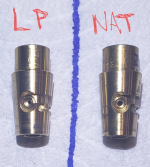Dmitriy_NY
New member
Hi, new guy here. Owner of various Weber grill over the time (and occasional char-broil that went to trash after a week ).
).
My current one is old Genesis, but recently i picked up ex-335 genesis ii smart grill. Story goes it got burned up, and the dude got it with an intent to fix from his client, but it was too much work. So yes, free for me...it was NG, so i will be doing the conversion to propane.
I do read a lot before bothering people, but instill have a few questions. Pretty much all the igniter wires are gone, as well as knobs. Cook box is warped at the bottom.
So far i fixed and painted the box, very small crack, but it works and accepts pan. All electronics work fine. I will be replacing the manifold to LP one.
Questions - tank scale, i think i can get any latest that accepts tank sensor, not specific genesis ii?
Burner tubes - same part number on all 4 for np. Lp are different parts, makes a difference and what is it? Maybe move spider covers a bit to adjust?
Gas regulator, i think i can get any weber model one?
I have an ocd and im pretty sure it will work fine without the tank scale or lighted up knobs, but i have to make it right
My current one is old Genesis, but recently i picked up ex-335 genesis ii smart grill. Story goes it got burned up, and the dude got it with an intent to fix from his client, but it was too much work. So yes, free for me...it was NG, so i will be doing the conversion to propane.
I do read a lot before bothering people, but instill have a few questions. Pretty much all the igniter wires are gone, as well as knobs. Cook box is warped at the bottom.
So far i fixed and painted the box, very small crack, but it works and accepts pan. All electronics work fine. I will be replacing the manifold to LP one.
Questions - tank scale, i think i can get any latest that accepts tank sensor, not specific genesis ii?
Burner tubes - same part number on all 4 for np. Lp are different parts, makes a difference and what is it? Maybe move spider covers a bit to adjust?
Gas regulator, i think i can get any weber model one?
I have an ocd and im pretty sure it will work fine without the tank scale or lighted up knobs, but i have to make it right



